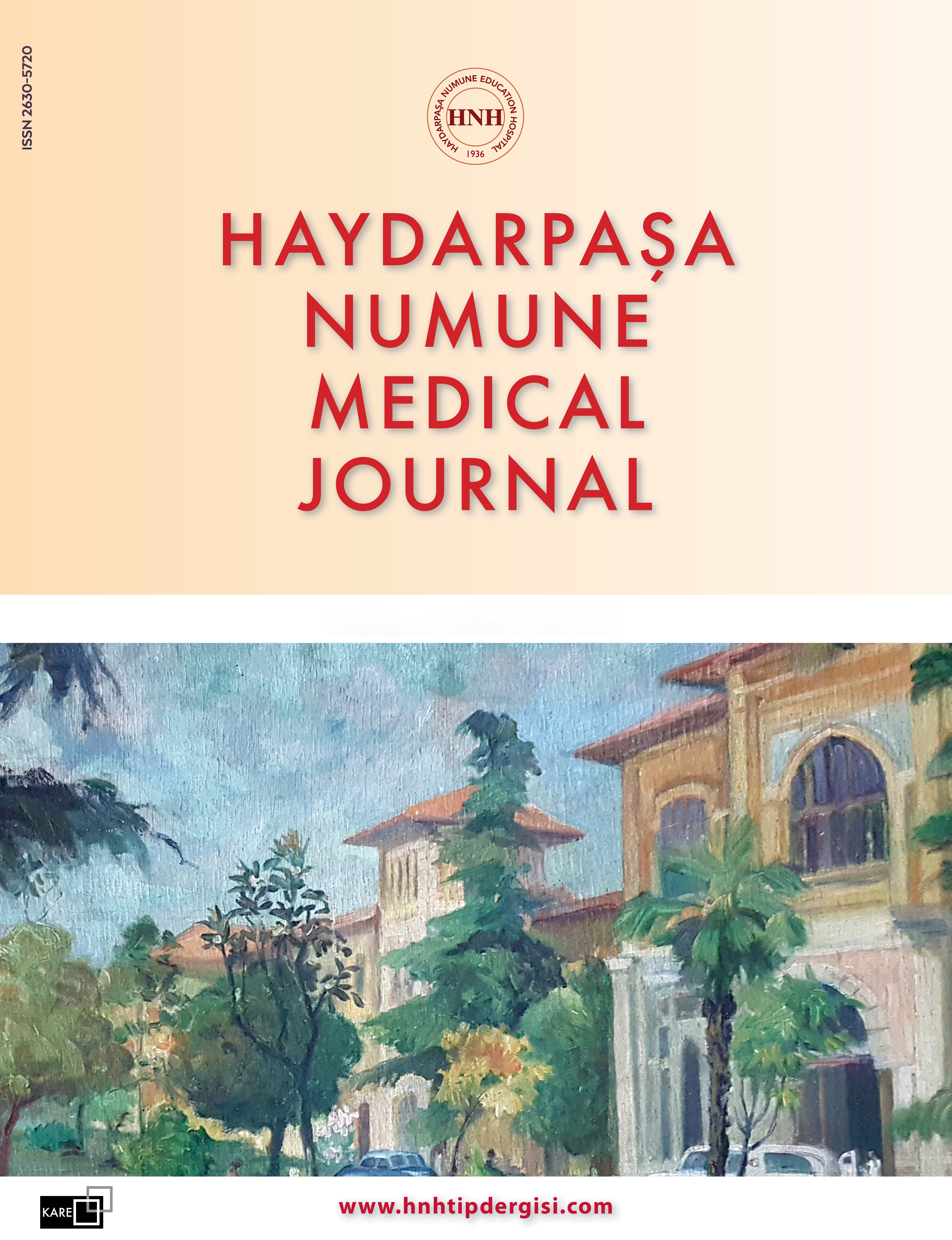Volume: 50 Issue: 3 - 2010
| RESEARCH ARTICLE | |
| 1. | Evaluation of macroalbuminuria Regression in Type 2 Diabetic Macroalbuminuric Patients Akın Dayan, Yaşar Sertbaş, Sami Sabri Bulgurlu, Gül Babacan Abanonu, Refik Demirtunç Pages 111 - 116 INTRODUCTION: Diabetic nephropathy is the leading cause of end-stage renal disease. Intensive multifactorial treatments can slow the progression of disease and even reverse it in some instances. In this study the incidence and predictors of regression of macroalbuminuria in patients with type 2 diabetes overt diabetic nephropathy were inves tigated in our routine clinical practice. METHODS: Thirty seven diabetic patients with persistent macroalbuminuria (urinary albumin excretion, UAE ?300 mg/24 hrs) who followed for 3-6 years (mean: 4.1±1.0 years) in our clinic were included; patients data was obtained from hospital records. Patients has divided into two groups according to the degree of UAE: <300 mg/24 hrs and ?300 mg/24 hrs. Baseline and follow-up laboratory and clinical parameters were compared between two groups. RESULTS: Mean age was 62.6 ± 8.4 years and duration of diabetes was 12.0 ± 7.8 years. All patients in the study were using insulin. UAE regressed in 14 patients (38%) to <300 mg/24 hrs. UAE decreased by 71% in regressors and increased by 228% in patients remaining macroalbuminuric. Creatine clearance was similarly decreased in both groups (22% vs. 17%, p=0.835). The percent change in UAE correlated positively with basal and follow-up levels of HbA1c (r=0.37, p=0.023 and r=0.58, p<0.001) and with follow-up triglyceride (r=0.37, p=0.024). Follow-up HbA1c and uric acid levels were significantly lower in regressors whereas baseline parameters were not significantly different between the groups. In regression analysis follow-up HbA1c was the only significant predictor of the level of albuminuria (OR: 8.0, 1.1-59.9, p=0.043). DISCUSSION AND CONCLUSION: Better glycemic control was the sole predictor of regression from macroalbuminuria in type 2 diabetic patient with macroalbuninuria. |
| CASE REPORT | |
| 2. | The Clinical and Laboratory Features of 36 Pulmonary Thromboembolism Patients Güliz Ataç, Selahattin Öztaş, Müge Özdemir, Gül Erdal, Sema Saraç, Gamze Ayar, Özlen Tümer, Melahat Kurutepe Pages 117 - 122 We retrospectively evaluated the diagnostic methods of 36 pulmonary thromboembolism patients diagnosed in our clinic. There were 20(55.6%)female and 16(44.4%)male patients with mean age 61.11± 16.1 years. |
| RESEARCH ARTICLE | |
| 3. | Resons of Conversion to Open Procedure in Delayed Laparoscopic Cholecystectomy Followin Acute Cholecystitis Ömer Faruk Özkan, Ediz Altınlı, Neşet Köksal, Atilla Çelik, Mehmet Ali Uzun, Münire Kayahan, Ersin Ergün, Ersan Eroğlu Pages 123 - 126 INTRODUCTION: The aim of this study is to assess the reasons for conversion to open procedure in acute cholecytitis treated medically for an interval of 6-8 weeks. METHODS: Between 2004 and 2009, patients whom were medically treated due to acute cholecystitis operarated following 6-8 weeks time interval are retrospectively evaluated. The cases which were converted to open procedure are recorded. The conversion reasons are retrospectively analyzed. RESULTS: 86 patients were operated after conser vative treatment of acute cholecystitis. 16 (%18.6) patients had conversion open procedure. The reasons for conversion to open procedure are dense adhesions in 8 cases, discrimation of anatomic landmarks in 2 cases, suspected gallbladder cancer in 2 patients, uncontrolablle hemorrhage in 2cases, suspected another organ pathology in 1 case and suspected duodenal injury in 1 case. DISCUSSION AND CONCLUSION: The appropriate timing for operation in the treatment of acute cholecystitis remains controversial. If it is necessary, conversion to open procedure during early or delayed interval laparoscopic cholecystectomy following acute cholecystitis could be done. |
| CASE REPORT | |
| 4. | Results of Open Structure Rhinoplasty Önder İhvan, Lütfü Şeneldir, Tanju Gökçeer, Sema Köksal Pages 127 - 132 Rhinoplasty is considered to be one of the most demanding operations in facial plastic surgery. Open rhinoplasty uses the open or external approach via a mid-columellar and bilateral marginal incision. |
| 5. | Evaluation of The Patients With Bacterial Meningitis in Terms of Development of Acute Complications Between May 2002 - May 2007 Follow-up Period in Haydarpaşa Numune Training and Research Hospital Tamay Özkozacı, Nurhan Ceviz Ozantürk, Suna Hancili, Esra Önal Sönmez, Narin Akıcı, Çağatay Nuhoğlu, Refik Demirtunç Pages 133 - 142 Meningitis, despite a better understanding of pathologic processes of the disease, the diagnostic methods and treatment still remains a problem. Childhood meningitis can cause high mortality and morbidity in spite of the new advanced diagnostic and treatment methods. |
| 6. | The Relation of Risk Factors Between Uric Acid and Prevalence of Coronary Artery Diseases Veli Gökçe, Mehmet Asıl, Ahmet Avcı, Ayşe Boyacı, Şuke Korkmaz Pages 143 - 150 Lipid peroxidation is known to be one of the important mechanisms taking role in the development of tissue damage observed in various ongoing physiologic and pathologic processes such as aging, atherosclerosis as well as various inflammatory diseases and cancer. |
| 7. | Tarsal Tunnel Syndrome: Review of The Literature Tuncay Kaner, Taşkan Akdeniz, İbrahim Tutkan Pages 151 - 158 Tarsal tunnel syndrome is an uncommon compression neuropathy of posterior tibial nerve and occurs in tarsal tunnel behind the medial malleolus. This article will review the anatomy, causes, clinical presentation, diagnosis, treatment and the result of treatment with the published reports. |
| 8. | Neutropenic Enterocolitis Following Adjuvant Chemotherapy Treatment: Report of a Case Aylin Acar, Mustafa Kaya, Orhan Alimoğlu Pages 159 - 162 Neutropenic enterocolitis, also termed typhilitis, is a necrotizing inflammatory acute disease of the bowel. Fifty one-year-old man who underwent right hemicolectomy, presented with abdominal pain, nause, vomiting and costipation following adjuvant chemoterapy treatment. |
| 9. | Apendix Mucocele Appearing on the Base of borderline Mucinous Tumor Mustafa Kaya, İbrahim Atak, Ali Kılıç, Gözde Kır, Orhan Alimoğlu Pages 163 - 165 Appendix mucocele of the appendix lumen due to abnormal accumulation of mucus is that expands into a cystic mass. Forty-three-year-old male patient was admitted to the emergency room because of abdominal pain continued for 2 days. |
















